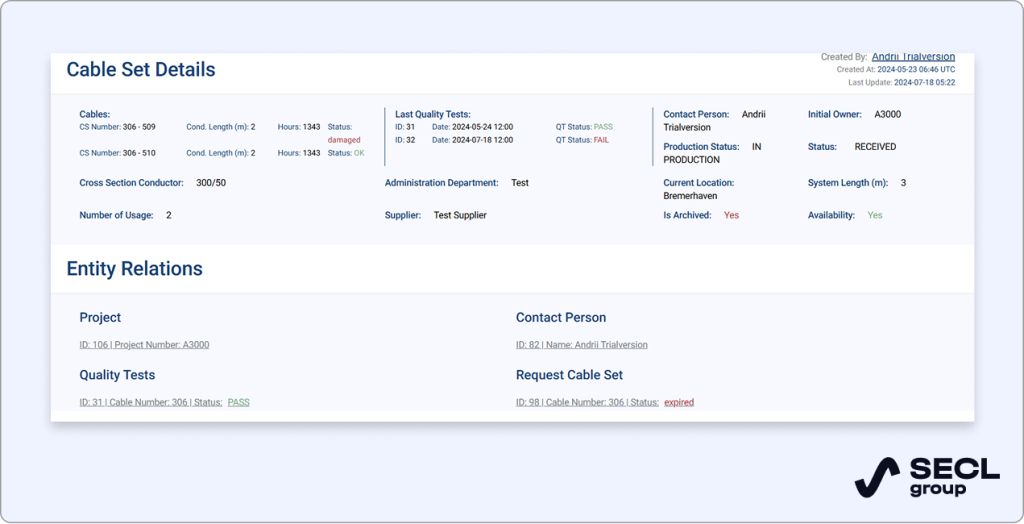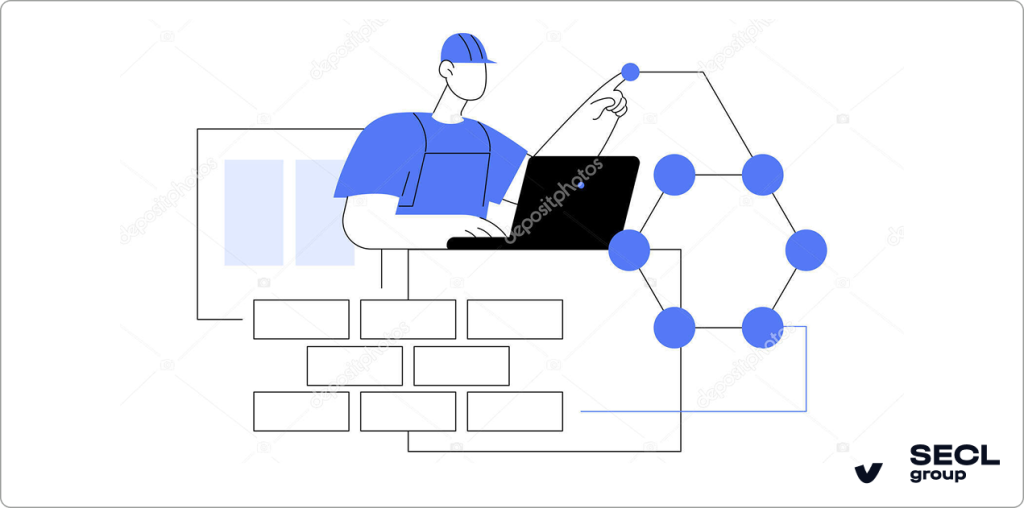- What is special about this project?
- A standard feature set of supply chain management systems
- Specific features of supply chain software for energy companies
- Business analytics
- Technology stack
- Security measures
- Integrations
- Quality assurance
- Team composition
- Final thoughts on our supply chain software development for TenneT
Our company specializes in developing complex internal solutions for enterprises across various domains. We have recently developed a supply chain management system for Tennet, one of the leading electricity transmission companies in Europe. This project illustrates our expertise in developing enterprise-grade internal systems.
We worked on this project for one and a half years, during which time our team handled various tasks, beginning with development from scratch and ending with complex integrations with, for instance, SAP. As a result, our client received a stable, feature-rich, and easy-to-navigate solution that meets the needs of the client’s employees and suppliers.

What is special about this project?
We developed a project for TenneT, a company that delivers electricity to 43 million domestic and business users in four European countries, Germany, the Netherlands, Denmark, and Belgium. The key challenge was to develop a supply chain solution that would help ensure that the company could deliver sustained effective operations; critical given the company’s involvement in essential electricity transmission services.
As an example, TenneT constructs power lines in various locations, including remote and difficult-to-access areas, and they work with multiple suppliers of different items in order to do so. This kind of operational environment makes it challenging to manage and collaborate with partners effectively.
Initially, communication between suppliers and client employees was handled via numerous Excel files, which wasn’t suitable for permanent use and would frequently lead to delays. Therefore, our client needed a comprehensive system that would dramatically improve their control over supplier and warehouse management, ultimately enhancing their overall project management. The client also aimed to automate a variety of processes and reduce paperwork.
There were a few other important prerequisites for the project. Currently, TenneT is undergoing the process of becoming a state-owned critical infrastructure company in Germany. As a result, part of our team was deployed to work in Germany since such companies are unable to receive services from overseas vendors. This condition was strictly necessary for protecting the company from external influences. We are proud to have been able to meet the strict quality standards demanded by TenneT, a critical infrastructure company, in order to successfully carry out this project.
A standard feature set of supply chain management systems
In this part of the article, we are going to discuss commonly found functionality of supply chain solutions. Bear in mind that this may differ based on project specifics and unique client objectives and requirements. For instance, our supply chain solution for TenneT was specifically designed to handle supplier communication and management, as well as fulfill their employees’ needs via a comprehensive self-service channel.
Let’s dive deeper into the core features of supply chain management software.
Inventory Management:
- Stock level tracking and management
- Automated stock updates, real-time visibility, and predictive analytics.
Logistics and Transportation Management:
- Transportation routes and scheduling optimization
- Strategic logistics planning
- Complex logistics management (i.e. involving multiple modes of transportation)
- Compliance with safety and environmental regulations for the transportation of hazardous materials.
Order Management:
- Real-time visibility over shipments and order status
- Contract management and compliance, and accurate billing
- Advanced reporting.
Supplier Relationship Management
- Supplier performance monitoring and evaluation
- Supplier base segmentation
- Communication and collaboration.
Cloud-Based Accessibility
- 24/7 online access to inventory level changes, order status, and shipment management.
Compliance and Data Security
- Data encryption and security measures
- Compliance with industry regulations like GDPR or CCPA.
Specific features of supply chain software for energy companies
Now that we’ve overviewed the common functionality typically implemented in supply chain management solutions, we want to provide more details on the specifics we implemented for TenneT, based on details we are at liberty to disclose under the terms of an NDA.
Cable management
We implemented cable management functionality, which included:
- Tracking cable usage;
- Checking if cable/s are in good working condition;
- Keeping a record of whether a cable is functional or damaged;
- Replacing cable components;
- Keeping a record of individuals responsible for each cable set;
- Allowing users to request the use of a specific cable;
- Tracking cable location and project.
This is what this functionality looks like from a user’s viewpoint:

Apart from delivering efficient inventory management and logistics, this functionality helps prevent costly equipment failures, unplanned outages, and expensive emergency repairs. This is essential for an energy transmission company.
Tower management
When it comes to tower management, this system allows users to track towers, their sections, and their delivery.
With effective cable and tower management, energy transmission companies can operate more safely and reliably. Functionality like this lowers the risk of delays, stock inconsistencies, and other supply chain issues.
Business analytics
At the beginning of our collaboration with TenneT, the client’s requirements were broad and ill-defined. Our team therefore provided comprehensive consultative support to help deliver a high-quality technical plan and delivery framework. Every 2 weeks we organized demo sessions with the client to present and discuss system functionality. Additionally, we conducted regular user scenario testing to ensure that everything worked as anticipated.
The business analysis phase allowed us to translate process bottlenecks into concrete, actionable requirements. Involving a qualified business analyst, we implemented changes that helped the project meet the client’s needs. In total, we created, reviewed, and approved more than 200 structured task specifications.
We defined two types of end user: suppliers and client employees, each with unique functionality requirements. We developed feature sets to cater to both of them, and our guiding principle was to ensure that the system was consistent and easy to navigate for everybody. Our development team generated over 100 improvement ideas, discussed them with the client and implemented the most relevant ones into the system.
Technology stack
As a rule, projects conducted for large companies like TenneT are developed based on their existing technology stack. Although enterprises usually work with a diverse set of technologies, there are still a few core technologies the company mostly relies on. In this case, these were PHP (Symfony) and JS (Angular).
Angular is a common choice for developing internal corporate applications. It is suitable for developing a wide range of forms and interfaces. If we are tasked with choosing our optimal front-end technology in such a solution, we would also choose this framework.
Symfony was also a preferred technology for the client since it boasts robust security and flexible architecture. It also has great integration capabilities, which was critically important when it came to integrating SAP with the client’s supply chain management solution.
While it would have been technically possible to achieve the same functionality within SAP, that approach would have been significantly more expensive due to both licensing and developer costs. If we had to choose the back-end technologies ourselves, we would opt for Python/Django as they enable even faster development.
For the database, we utilized MySQL because it is a cost-effective, widely recognized and reliable solution. It can handle significant information volumes, which makes a system highly scalable. It also integrates well with different platforms and facilitates fast and seamless data exchange.
Security measures
Generally, enterprises have complex, multi-level security requirements for software projects. These are especially high when developing critical systems like supply chain management software. To protect this vital data, we implemented bank-level security measures.
As a rule, only the client has access to the production server. Software engineers are not granted access to critical information and supplier databases regardless of their level of involvement in the project. Any changes to code are routed to the client’s team lead and undergo a thorough security review. They are deployed into production only after they meet strict security requirements. And this is just the primary level of data protection measures we implement for such projects.
We also implemented user roles and permissions across the whole system functionality to ensure data security. With role-based access control, the supplier’s access is connected only to data relevant to their company and role. They cannot access information about activities or sales from other suppliers.
The DMZ is another level of security. It is used to control server access, prevent servers from accessing unnecessary resources, and restrict communication between servers within the DMZ to required ports only. On this project, the DMZ enhances data access limitations, not only through IT system setup, but also through server configurations, strengthening our two-tiered data protection approach.
As ever, consistent software updates are crucial for addressing potential weaknesses and improving overall system security. This is a general rule that applies to all kinds of internal corporate software.
Integrated security rules within frameworks are also essential. They prevent basic mistakes and guide programmers toward best practices. That’s why you can benefit from working with an experienced team familiar with many technologies and frameworks to ensure that you make the right choices.
Client-side security specialists are frequently involved in defining development requirements and verifying compliance. At SECL Group, our team has significant experience with critical enterprise projects and is skilled at recognizing and resolving common security vulnerabilities.
Integrations
Integration with internal and external systems is a key stage in enterprise software development. Introducing a new solution with an existing intricate software ecosystem requires guaranteed compatibility with what’s already there. This makes off-the-shelf solutions problematic, as integrating them often involves many challenges.
For this project, we implemented a third-party integration with SAP. As a rule, third-party integrations with such popular systems require detailed specifications and expertise from a development team.

Quality assurance
QA is essential when deploying a stable, secure, and functional internal solution. On this project, we implemented robust testing measures, including auto, unit, and manual testing. Such a combination allowed us to thoroughly test new features that were added to system functionality. We also conducted security and integration testing to ensure the system is working and exchanging data with third-party solutions correctly.
Furthermore, we completed unit testing for this project. For automated testing, we utilized Python + Robot Framework, a combination of technologies that allowed us to achieve broader test coverage, catch and fix bugs early on, and lower the cost of overall testing.
Team composition
Overall, we engaged 8 specialists on this project. The team included a PM, a QA engineer, business analyst, DevOps engineer, a team lead, 2 front-end and 2 back-end developers. We worked on this project for more than a year.
The team composition is highly dependent on unique project requirements and scale. If we were to involve more software developers, we would also hire an additional project manager. We can also recruit additional employees at the client’s request, which is common for larger projects. In such cases, only a part of our team is derived from our internal talent pool.
Final thoughts on our supply chain software development for TenneT
As a result of our collaboration with TenneT, we developed a user-friendly and comprehensive supply chain management solution. We managed to develop a highly functional system. Now TenneT benefits froman intuitive solution for suppliers, warehouse managers, and project managers, as well as a self-service channel for the company’s employees.
Developing such an enterprise-grade solution is a complex task since it is used to help the client provide electricity transmission services. This made our work more challenging as any supply chain delays or interruptions in the company’s operations could result in inefficient service delivery. If you’re planning to develop a similar system for your business, we invite you to contact us to discuss collaboration.